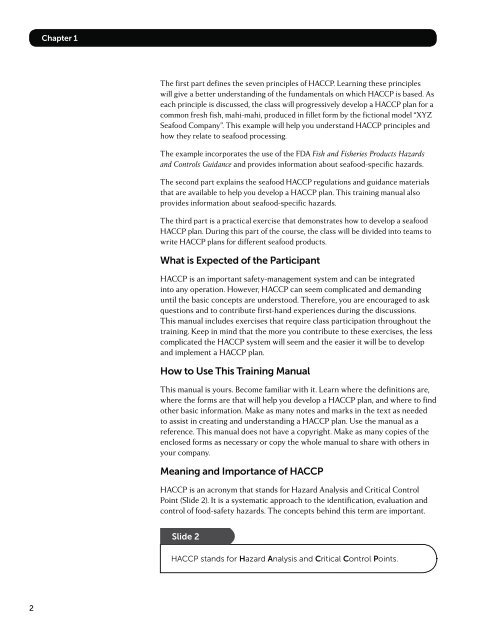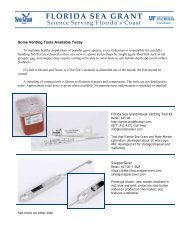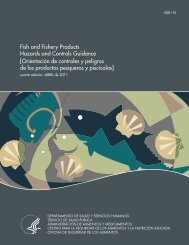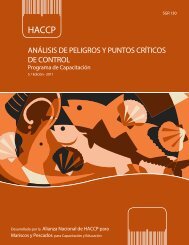HACCP
Hazard Analysis and Critical Control Point - Florida Sea Grant
Hazard Analysis and Critical Control Point - Florida Sea Grant
- No tags were found...
You also want an ePaper? Increase the reach of your titles
YUMPU automatically turns print PDFs into web optimized ePapers that Google loves.
Chapter 1<br />
The first part defines the seven principles of <strong>HACCP</strong>. Learning these principles<br />
will give a better understanding of the fundamentals on which <strong>HACCP</strong> is based. As<br />
each principle is discussed, the class will progressively develop a <strong>HACCP</strong> plan for a<br />
common fresh fish, mahi-mahi, produced in fillet form by the fictional model “XYZ<br />
Seafood Company”. This example will help you understand <strong>HACCP</strong> principles and<br />
how they relate to seafood processing.<br />
The example incorporates the use of the FDA Fish and Fisheries Products Hazards<br />
and Controls Guidance and provides information about seafood-specific hazards.<br />
The second part explains the seafood <strong>HACCP</strong> regulations and guidance materials<br />
that are available to help you develop a <strong>HACCP</strong> plan. This training manual also<br />
provides information about seafood-specific hazards.<br />
The third part is a practical exercise that demonstrates how to develop a seafood<br />
<strong>HACCP</strong> plan. During this part of the course, the class will be divided into teams to<br />
write <strong>HACCP</strong> plans for different seafood products.<br />
What is Expected of the Participant<br />
<strong>HACCP</strong> is an important safety-management system and can be integrated<br />
into any operation. However, <strong>HACCP</strong> can seem complicated and demanding<br />
until the basic concepts are understood. Therefore, you are encouraged to ask<br />
questions and to contribute first-hand experiences during the discussions.<br />
This manual includes exercises that require class participation throughout the<br />
training. Keep in mind that the more you contribute to these exercises, the less<br />
complicated the <strong>HACCP</strong> system will seem and the easier it will be to develop<br />
and implement a <strong>HACCP</strong> plan.<br />
How to Use This Training Manual<br />
This manual is yours. Become familiar with it. Learn where the definitions are,<br />
where the forms are that will help you develop a <strong>HACCP</strong> plan, and where to find<br />
other basic information. Make as many notes and marks in the text as needed<br />
to assist in creating and understanding a <strong>HACCP</strong> plan. Use the manual as a<br />
reference. This manual does not have a copyright. Make as many copies of the<br />
enclosed forms as necessary or copy the whole manual to share with others in<br />
your company.<br />
Meaning and Importance of <strong>HACCP</strong><br />
<strong>HACCP</strong> is an acronym that stands for Hazard Analysis and Critical Control<br />
Point (Slide 2). It is a systematic approach to the identification, evaluation and<br />
control of food-safety hazards. The concepts behind this term are important.<br />
Slide 2<br />
<strong>HACCP</strong> stands for Hazard Analysis and Critical Control Points.<br />
2








